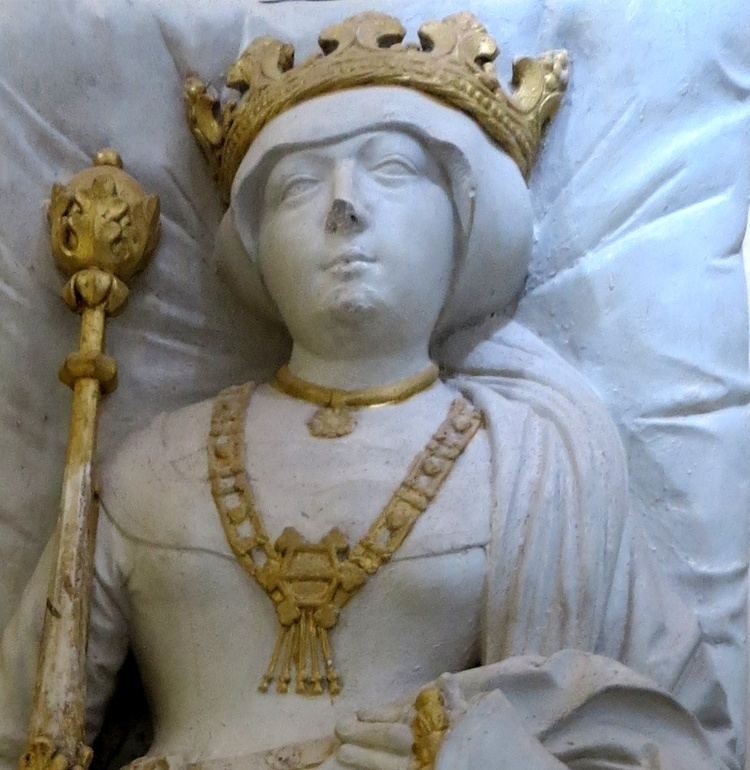Role Queen of Germany | Name Gertrude Sulzbach | |
 | ||
Tenure 7 March 1138 – 14 April 1146 House House of Hohenstaufen(by marriage) Died April 14, 1146, Bad Hersfeld, Germany Parents Adelheid of Wolfratshausen, Berengar II of Sulzbach Children Henry Berengar, Frederick IV, Duke of Swabia People also search for | ||
Gertrude of Sulzbach (German: Gertrud von Sulzbach; c. 1110 – 14 April 1146) was Queen consort of Germany from 1138 until her death, as second wife of the Hohenstaufen king Conrad III.
Contents
Family
She was a daughter of the Bavarian count Berengar II of Sulzbach (c.1080–1125) and his second wife Adelheid of Wolfratshausen (d. 1126).
Berengar was a son of Count Gebhard II of Sulzbach (d. 1085) and Irmgard of Rott (d. 1101). Irmgard was a daughter of the Bavarian count palatine (Pfalzgraf) Kuno I of Rott, founder of Rott Abbey, and his wife Uta. There is a theory identifying her mother as a daughter of Count Frederick III of Andechs-Diessen, however, this is not confirmed by primary sources. Countess Irmgard is mentioned as the founder of the Augustinian chapter in Berchtesgaden. There is mention of her marrying twice but the identity of her second husband is disputed. The most likely candidate is Count Kuno II of Horburg.
Gertrude's grandfather Gebhard II is generally considered identical with Count Gebhard I of Sulzbach, the first person known to have used this comital title. On 28 November 1043, Gebhard was granted property by charter of King Henry III of Germany, whereby his mother is mentioned as "Adalheit". The Genealogische Tafeln zur mitteleuropäischen Geschichte genealogy (1965–1967) by Wilhelm Wegener identifies her as Adelaide of Susa (d. 1091); his father therefore being Duke Herman IV of Swabia. This theory has gained some acceptance. However Charles Cawley notes that this would place Gebhard's birth c. 1037–1038. In order for him to have grandchildren by the 1080s, "this would require a succession of teenage bridegrooms which seems improbable." Wegener theorises the wife of Gebhard I to have been a daughter of Berengar, Count in the Bavarian Nordgau. He suggests that Sulzbach was part of her dowry. Cawley considers the theory to stand only on "the transmission of the name Berengar into her husband's family." Otherwise no connection between the families is known to exist.
The identity of Gertrude's mother is mentioned in the Kastler Reimchronik, Vers 525. Adelheid of Wolfratshausen is mentioned in various other documents of the 12th century as "Countess of Sulzbach", without mentioning her husband. De Fundatoribus Monasterii Diessenses contains a rather confused genealogy concerning her two most prominent daughters. Otto II, Count of Wolfratshausen, father of Adelheid, is given as father to Richenza of Northeim, "Empress" and "Maria, Empress of the Greeks". Richenza was actually empress consort of Lothair II. The author of the text had apparently confused her with Gertrude von Sulzbach. Maria is probably a confusion for "Irene", the baptismal name of Gertrude's sister Bertha of Sulzbach, wife of Manuel I Komnenos. Both were granddaughters of Otto and children of Count Berengar and Adelheid.
At the time of Gertrude's birth, in 1111, Count Berengar II was among the nobles attending the coronation of the last Salian emperor Henry V. He is mentioned among the sureties of documents related to the coronation. In 1120, Berengar is recorded granting a donation to the Prince-Bishopric of Bamberg. He is mentioned as co-founder of Kastl Abbey about 1103 and as the founder of the Berchtesgaden monastery on behalf of his late mother in 1101/02, as well as of Baumburg Abbey about 1107/09. On 23 December 1122, he was one of the German nobles who signed the Concordat of Worms between Emperor Henry V and Pope Callixtus II. In August 1125, Berengar is mentioned in documents of Henry's successor King Lothair II of Germany; his death is documented four months later.
The known siblings of Gertrude include:
- Adelheid, Abbess of the Niedernburg monastery at Passau
- Bertha of Sulzbach (d. 1158/60), Byzantine Empress (baptised Irene) as wife of Emperor Manuel I Komnenos
- Luitgarde (d. after 1163), wife first of Count Godfrey II of Louvain, Duke of Lower Lorraine, and secondly of Hugo XII, Count of Dagsburg and Metz
- Matilda of Sulzbach (d. 1165), wife of Margrave Engelbert III of Istria
- Gebhard III, Count of Sulzbach (d. 1188), married Matilda, daughter of Duke Henry IX of Bavaria in 1129.
Marriage
Gertrude married Conrad of Hohenstaufen, son of late Duke Frederick of Swabia, in 1136. While Conrad's elder brother Frederick II had succeeded their father as Duke of Swabia, he himself was elected German anti-king in 1127, but had to witness the coronation of his rival Lothair II as Holy Roman Emperor in 1133. Conrad finally submitted in 1135; the next year he joined the emperor on his Italian campaign and married Gertrude. The matrimonial alliance between the House of Hohenstaufen and the Counts of Sulzbach led to close relations between the two families; when in Gertrude's brother Count Gebhard III died, the line became extinct, leaving the Hohenstaufen emperor Frederick I Barbarossa (Gertrude's nephew by marriage) as his sole heir.
After Emperor Lothair II died in 1137, Gertrude's husband Conrad finally was elected King of the Romans on 7 March 1138, though he had to ward off the claims raised by the rivalling Welf duke Henry X of Bavaria and his sons Henry the Lion and Welf VI. To secure the Hohenstaufen rule, Conrad had the princes elect his son Henry Berengar, then ten years old, as co-King of Germany at an Imperial diet held in Regensburg on 13 March 1147
At that time, Gertrude had already died at Hersfeld Abbey, as she became ill after the birth of her second son Frederick. She was 36 years old, and was buried in the church of the former Cistercian monastery of Ebrach, right next to her younger son.
Issue
From her marriage with Conrad III, Gertrude had two sons:
